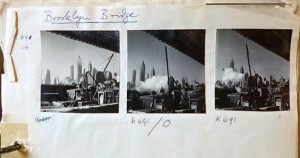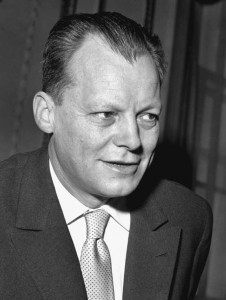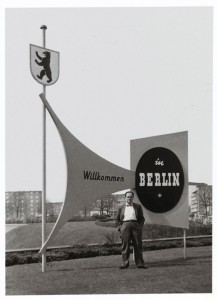My Week of Intensive Research into Fred Stein’s Archives

Contact sheet Brooklyn Bridge
© Estate of Fred Stein, photo: Theresia Ziehe
In June of 2012 I had the opportunity to delve into the estate of Fred Stein. During the preparation for our then-upcoming exhibition “In an Instant,” I travelled to the little town of Stanfordville, NY to visit Peter Stein, the photographer’s son and archive administrator. For a week, I studied the voluminous and multi-faceted material stored in various rooms of the private residence. It was an unforgettable immersion into the life and work of Fred Stein.
Hundreds of negatives, kept in fireproof cabinets, make up the core of the collection. Their differing formats point to the two cameras Stein photographed with: coiled strips of Leica negatives and individually packaged 2 1/4 x 2 1/4 inches negatives in pergamin sheets from the Rolleiflex. The cameras themselves unfortunately didn’t survive. Among these negatives, you can see Stein’s first shots of Dresden shortly before he emigrated to Paris in 1933. → continue reading
“Hello. My name is Fred Stein, I’m a photographer, left-wing, and I would like to take your picture.”
This is how Fred Stein used to strike up a conversation with people he hoped to portray. Between 1933 and 1967 he managed to make more than 1,200 portraits this way. The words show he had not only the courage to approach people, but also a talent for quickly putting those who had caught his eye at ease.

Willy Brandt, New York 1957
© Estate of Fred Stein
Fred Stein took a passionate interest both in those he portrayed and their work. With André Malraux, Arthur Koestler, Egon Erwin Kisch, and countless other peers he discussed the political landscape in Europe of the 1930 and 40s. Willy Brandt and he became firm friends and remained so all their lives long, and likewise others whose portrait he made. In a letter of 10 May 1983, Brandt recalled:
“I met Fred Stein when we were both refugees and fighting the totalitarian Nazi regime with the rather modest means at our disposal. He was a man ahead of his time, an avant-garde and brilliant photographer, inspired by the commitment to justice and concern for truth so clearly reflected in his photographs. → continue reading
Fred Stein was only twenty-four years old when he had to flee Germany in 1933. A rabbi’s son and member of the Socialist Workers’ Party, he had studied law and hoped to work as an attorney, defending people’s rights. When he learned by chance that the Gestapo was planning to arrest him, he and his wife Lilo fled to Paris under the pretext of taking a honeymoon trip. In exile, the young couple was obliged to rethink its future.

Fred Stein, Berlin 1958
© Estate of Fred Stein
A Leica camera, the wedding present they had bought for themselves, proved to be the key to a new career. Fred Stein began taking photographs: street scenes in downtown Paris and portraits of celebrities, many of whom were German emigrants. In 1941 Fred and Lilo Stein, who by then had a little daughter, managed to flee a second time. They reached New York on one of the last ships out. There, Fred Stein once again devoted himself to shooting portraits and street scenes.
In 1958 Fred Stein returned to Germany for the first time in twenty-five years. He was prompted to do so by Will Grohmann’s planned publication of the book Deutsche Porträts [German Portraits]. Fred Stein was commissioned to photograph Konrad Adenauer, Heinrich Lübke, Ludwig Erhard, and other politicians, as well as artists, authors, and publishers, such as the young Axel Springer, or Rudolf Augstein. Yet apparently, many a German head he portrayed for the book posed a dilemma for him. → continue reading


